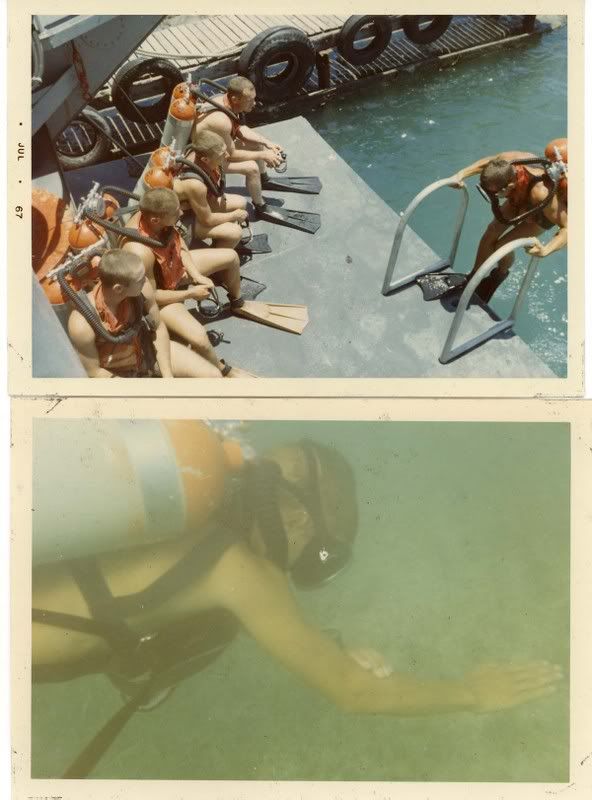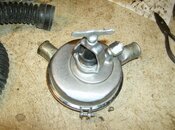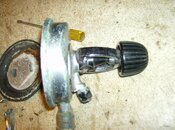You are using an out of date browser. It may not display this or other websites correctly.
You should upgrade or use an alternative browser.
You should upgrade or use an alternative browser.
Questions For Double Hose Regulator use
- Thread starter Wetsuit 4 life
- Start date
Please register or login
Welcome to ScubaBoard, the world's largest scuba diving community. Registration is not required to read the forums, but we encourage you to join. Joining has its benefits and enables you to participate in the discussions.
Benefits of registering include
- Ability to post and comment on topics and discussions.
- A Free photo gallery to share your dive photos with the world.
- You can make this box go away
You can eyeball approximate the above positioning by yourself by holding the reg upside down with the hoses hanging (gravity substituting for buoyancy) with the can and mouthpiece in the correct positions relative to each other. The thing is to ensure that both hoses are adjusted so that neither is putting any torque on the mouthpiece (evidenced by them not hanging freely or equally).To be truely vintage use a sundial for the hose orientation. Alternately, hang the SCUBA on your back, grip the mouthpiece, look straight ahead and have a second party manipulate the hoses at the regulator until the mouthpiece is comfortable. Request that person lift each hose as to simulate buoyancy. Apply marks on the hose ends and the regulator. Later, use the marks to clamp the hoses. Take notes, the hoses are mounted at different distances from the regulator face due to the design. This means that the left and right hoses may have slightly different orientations to feel right.
When figuring weighting of the belt, bear in mind that each hose has about 1 lb buoyancy. This may eliminate the need for ankle weights, if they are normally used.
OK
What I want to do is change the thumb screw yoke on my working double hose with the one in the second image, I hoping that's all I'll have to be to make my double hose work safely with my 3000 psi tanks. Or do I even have to do this? Would the thumb screw yoke work with my AL 80's?
So would this work? and how would I remove the yoke?
Once again thanks to everybody for the advice and support
Dave
What I want to do is change the thumb screw yoke on my working double hose with the one in the second image, I hoping that's all I'll have to be to make my double hose work safely with my 3000 psi tanks. Or do I even have to do this? Would the thumb screw yoke work with my AL 80's?
So would this work? and how would I remove the yoke?
Once again thanks to everybody for the advice and support
Dave
Attachments
The older thin yoke would work fine at 2250 psi steel 72 pressures, but they can potentially stretch at 3000 psi service pressures creating increased risk of o-ring extrusion.
Whether it would fit on an AL 80 depends on the tank valve but you should not have any problems with the average Sherwood or Thermo K or DIN/K valve. The main issue with the older "short" yoke is that there is not enough room for it to accommodate a banjo fitting to enable you to use an SPG, making the later style 'long" yoke more desireable.
To swap yokes you would just screw the nozzle off the main body of the DA (start with the bad one) until it screws all the way out. The yoke then just slides off. Nothing special, just regular lefty-loosey, righty-tighty threads. Do the same with the other DA and swap the yokes.
You will note a small brown phenolic resin washer in the bottom of the hole where the nozzle screws into the main body. That is what provides a high pressure seal. The odds are good that when you screw the same nozzle back in with the new yoke on it that it will seal. You just have to be sure to tighten it enough to seal, but not so much as to crush things too much. Check to be sure it is not leaking. It should reseal but if not, you can get new washers from Bryan at vintagedoublehose.com. They also have a great forum there.
That said, DA seats tend to wear quite a bit faster at 3000 psi service pressures and they are a lot happier at 2250-2500 psi presures. You can resurface worn seats but it is a bit of a pain and new ones are still fairly expensive. If you plan on diving it a lot a steel 72 or a low pressure 2400 psi steel tank is a good investment.
The Royal Aquamasters handle high pressures better and use modern conshelf/titan seats. Another option is to go with the Phoenix nozzle that essentially converts a DA to RAM status plus provides 3 HP and 3 LP ports.
Whether it would fit on an AL 80 depends on the tank valve but you should not have any problems with the average Sherwood or Thermo K or DIN/K valve. The main issue with the older "short" yoke is that there is not enough room for it to accommodate a banjo fitting to enable you to use an SPG, making the later style 'long" yoke more desireable.
To swap yokes you would just screw the nozzle off the main body of the DA (start with the bad one) until it screws all the way out. The yoke then just slides off. Nothing special, just regular lefty-loosey, righty-tighty threads. Do the same with the other DA and swap the yokes.
You will note a small brown phenolic resin washer in the bottom of the hole where the nozzle screws into the main body. That is what provides a high pressure seal. The odds are good that when you screw the same nozzle back in with the new yoke on it that it will seal. You just have to be sure to tighten it enough to seal, but not so much as to crush things too much. Check to be sure it is not leaking. It should reseal but if not, you can get new washers from Bryan at vintagedoublehose.com. They also have a great forum there.
That said, DA seats tend to wear quite a bit faster at 3000 psi service pressures and they are a lot happier at 2250-2500 psi presures. You can resurface worn seats but it is a bit of a pain and new ones are still fairly expensive. If you plan on diving it a lot a steel 72 or a low pressure 2400 psi steel tank is a good investment.
The Royal Aquamasters handle high pressures better and use modern conshelf/titan seats. Another option is to go with the Phoenix nozzle that essentially converts a DA to RAM status plus provides 3 HP and 3 LP ports.
Care needs to be taken when swapping the yokes. When you remove the nozzle, there will be a small pin and a "mushroom" located between the nozzle and the diaphram. These parts are (or at least should be- some I have seen are stuck) loose and will fall out. The pin is small and easy to lose. It is critical these parts go back where they are suspose to be. I like to preassemble the yoke, nozzle, pin and mushroom, keeping the assembly upside down (yoke knob down) then screw the main body onto the nozzle. This way you ensure the pin and mushroom remain in the correct location until it seats on the diaphram.
Okay, I wasn't going to say anything here as I haven't disassembled my DA Aquamaster in quite some time. But when it is disassembled, it should be taken completely apart. That means that the case needs to be opened, the top and bottom boxes separated, the LP diaphragm removed, then you can get to the first stage. You may need to remove the horseshoe which activates the second stage, but it is difficult to do this without first unscrewing the nut on the seat holder and disc assembly. Then the adjusting screw is removed, the main spring removed, then the spring retainer needs to be unsrcewed with a wrench. The spring pad will be found on top of the HP diaphragm, and that needs to be taken off (it sometimes gets stuck on), and the gasket and HP diaphragm removed. The pin that herman is speaking of can then be seen with a pin support disc on top of it.
With that inside part of the first stage removed, the HP nozzle can be removed. But removal is much easier, and better for the regulator's finish, if you have a USD body wrench. It can also probably be made, as it is a keyhole-like affair which fits over the outside of the back of the regulator. The body wrench allows leverage to be applied to the assembly to remove it with another wrench on the body assembly. Once that assembly is removed, then the yolk can be replaced.
The reverse process is used to re-assemble the unit. The pin is put into the body with the nozzle already in place, so that it cannot be lost or hit the seat at the wrong angle. Then the parts are re-assembled in reverse order from above. The interstage pressure is re-set, and the regulator re-assembled. The body wrench is pretty necessary for this work, as in order to tighten the nozzle assembly against the gasket (it depends on tightness, as there is no O-ring seal in this regulator) enough pressure needs to be applied to ensure a seal.
What I'm saying is that it is much better to have this done by either VSS or VDH, as they have the tools to do it correctly.
One other thing to realize is that the U.S. Navy divers used the DA Aquamaster on 3000 psi systems extensively, without any modifications. The scuba shown in the photos below were all 3000 psi systems.

Occasional use at around 3000 psi (or just a bit below) probably won't make much difference with your DA Aquamaster. But if you are using them extensively at 3000 psig, then a new yolk would be indicated. Age would tend to weaken the yolk, and you don't know its past use.
John
With that inside part of the first stage removed, the HP nozzle can be removed. But removal is much easier, and better for the regulator's finish, if you have a USD body wrench. It can also probably be made, as it is a keyhole-like affair which fits over the outside of the back of the regulator. The body wrench allows leverage to be applied to the assembly to remove it with another wrench on the body assembly. Once that assembly is removed, then the yolk can be replaced.
The reverse process is used to re-assemble the unit. The pin is put into the body with the nozzle already in place, so that it cannot be lost or hit the seat at the wrong angle. Then the parts are re-assembled in reverse order from above. The interstage pressure is re-set, and the regulator re-assembled. The body wrench is pretty necessary for this work, as in order to tighten the nozzle assembly against the gasket (it depends on tightness, as there is no O-ring seal in this regulator) enough pressure needs to be applied to ensure a seal.
What I'm saying is that it is much better to have this done by either VSS or VDH, as they have the tools to do it correctly.
One other thing to realize is that the U.S. Navy divers used the DA Aquamaster on 3000 psi systems extensively, without any modifications. The scuba shown in the photos below were all 3000 psi systems.

Occasional use at around 3000 psi (or just a bit below) probably won't make much difference with your DA Aquamaster. But if you are using them extensively at 3000 psig, then a new yolk would be indicated. Age would tend to weaken the yolk, and you don't know its past use.
John
Last edited:
OK
What I want to do is change the thumb screw yoke on my working double hose with the one in the second image, I hoping that's all I'll have to be to make my double hose work safely with my 3000 psi tanks. Or do I even have to do this? Would the thumb screw yoke work with my AL 80's?
So would this work? and how would I remove the yoke?
Once again thanks to everybody for the advice and support
Dave
I think that yoke should work just fine from what I see. I believe that si the yoke that was later supplied on the very last round label RAMs. It easily handles 3,300 psi.
I have a homemade body wrench but I don't use it. I hold the body in my hand and torque the nozzle with the other. I prefer the nylon seals to the older fiber types. The nylon washers have a small amount of "squish" to them.
N
halocline
Contributor
I really don't see the purpose of disassembling the entire reg just to replace the yoke. In fact, to me it makes more sense to install the 1st stage diaphragm before the nozzle, so that it can seat in a relaxed position without the pin/pad from the nozzle pushing on it.
Why don't you just put the pin/pad in the nozzle, hold it upside down so it stays put, and carefully screw it in. Am I missing something?
One other question, I'm trying to figure out why 3000 PSI would cause accelerated wear in the seat. Certainly the pressure differential across the the seat/orifice junction is greater, but still the seat is only going to sit against the orifice with the minimum force necessary to close it, correct? The IP (on the other side of the orifice) will be lower due to the increased upstream pressure on the seat, but unless I'm missing something, the sum of the two forces will stay constant to produce the seating force. Right? One thing I could see causing seat wear is any imperfection in the orifice that results in greater necessary seating force.
Why don't you just put the pin/pad in the nozzle, hold it upside down so it stays put, and carefully screw it in. Am I missing something?
One other question, I'm trying to figure out why 3000 PSI would cause accelerated wear in the seat. Certainly the pressure differential across the the seat/orifice junction is greater, but still the seat is only going to sit against the orifice with the minimum force necessary to close it, correct? The IP (on the other side of the orifice) will be lower due to the increased upstream pressure on the seat, but unless I'm missing something, the sum of the two forces will stay constant to produce the seating force. Right? One thing I could see causing seat wear is any imperfection in the orifice that results in greater necessary seating force.
I'm not trying to disagree needlessly with anyone who is a vintage expert and former PJ, but if you want to learn how to rebuild your DA, you can always get the manual, it's really not very hard. You don't really need anything special to do it other than average intelligence and some hand tools. Bryan at VDH can tune a doublehose like a harp from hell, his skills are second to none. It's not hard to rebuild one, but it is hard to make one breathe like he can.
If it makes you feel any better, my first doublehose was a mistral, I've rebuilt it twice already, and it's very simple. A DA is a little more complex, but not much. If you have access to a pool or a dive shop, you can dive it in the pool or use a magnahelic to calculate cracking pressure.
I think my point is, don't get discouraged man. Oh yeah, and I never disassemble my reg just to change yokes. Personally, as a guy who repairs regulators all the time at the shop I work at, I can't really see a reason for it unless your need for yoke changing happens to coincide with your need for reg service. JMO, YMMV, yada yada yada...
If it makes you feel any better, my first doublehose was a mistral, I've rebuilt it twice already, and it's very simple. A DA is a little more complex, but not much. If you have access to a pool or a dive shop, you can dive it in the pool or use a magnahelic to calculate cracking pressure.
I think my point is, don't get discouraged man. Oh yeah, and I never disassemble my reg just to change yokes. Personally, as a guy who repairs regulators all the time at the shop I work at, I can't really see a reason for it unless your need for yoke changing happens to coincide with your need for reg service. JMO, YMMV, yada yada yada...
I don't take the reg apart just to work on the first stage nozzle assembly. I insert the pin and push pad and as was mentioned hold it upright so that the pin does not fall out, set the nylon washer on the nozzle and "glue" it with a dab of lube and then thread the body/assembly onto the nozzle.
N
N
Similar threads
- Replies
- 10
- Views
- 957
- Replies
- 12
- Views
- 995







